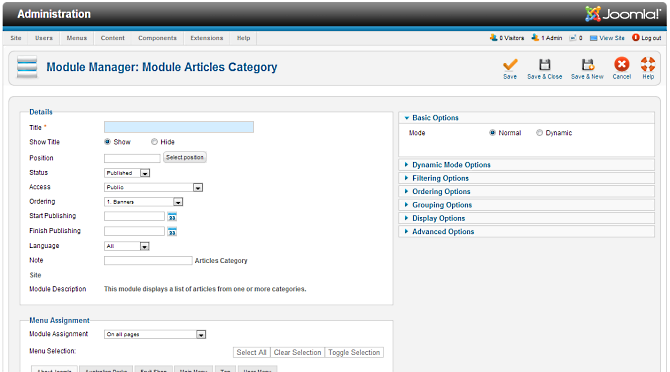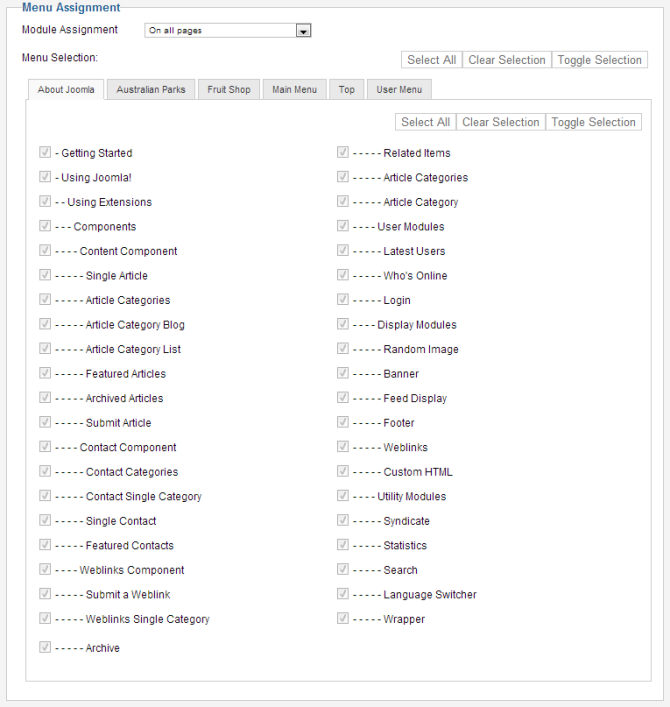Extensions Module Manager Articles Category
From Joomla! Documentation
How to Access[edit]
To 'add' a new Articles Category module or 'edit' an existing Articles Category module, navigate to the Module Manager:
- Select Extensions → Module Manager
Click the 'New' button and click on Articles Category in the modal popup window.
To 'Edit' an existing Articles Category module, in the Module Manager click on an Articles Category Modules Title or click the Articles Category modules check box and then click the Edit button in the Toolbar.
Description[edit]
This module displays a list of articles from one or more categories.
Screenshot[edit]
Details and Options[edit]
Details[edit]
- Title. The title of the module. This is also the title displayed in the front end for the module depending on the Show Title Form Field
- Show Title. (Show/Hide) Choose whether to show or hide the modules title in the front end. The title will be the one in the Form Field above.
- Module Position. Choose the module position you wish this module to be displayed in. A custom module position can be entered for use with the load position plugin or the position button can be pressed to select a module position from the template.
- Status. (Published/Unpublished/Archived/Trashed) The published status of the item.
- Access. The viewing level access for this item.
- Module Ordering. This shows a drop down of every module in the position that the current module is in. This is the order that the modules will display in when displayed on in the front end as well as in the Module Manager.
- Start Publishing. Date and time to start publishing. Use this field if you want to enter content ahead of time and then have it published automatically at a future time.
- Finish Publishing. Date and time to finish publishing. Use this field if you want to have content automatically changed to Unpublished state at a future time (for example, when it is no longer applicable).
- Language. Item language.
- Note. Item note. This is normally for the site administrator's use (for example, to document information about this item) and does not show in the front end of the site.
Basic Options[edit]
- Mode. (Normal/Dynamic) If Normal Mode is chosen, then simply configure the module and it will display a static list of Articles on the menu items you assign the module to. If Dynamic Mode is chosen, then you can still configure the module normally, however now the Category option will no longer be used. Instead, the module will dynamically detect whether or not you are on a Category view and will display the list of articles within that Category accordingly. When Dynamic Mode is chosen, it is best to leave the module set to display on all pages, as it will decide whether or not to display anything dynamically.
Dynamic Mode Options[edit]
- Show on Article Page. (Show/Hide) Choose whether to display the module on article pages or not. If hidden the module will only display itself dynamically on category pages.
Filtering Options[edit]
Ordering Options[edit]
- Articles Field to Order By. Order of articles in this Layout. The following options are available.
- Article Manager Order: Use the default value from the component options screen.
- Featured Articles Order: Articles are ordered according to the Order column entered in Article Manager: Featured Article.
- Hits: Articles are ordered by the number of hits
- Title: Articles are ordered by Title
- ID: Articles are ordered by their ID
- Alias: Articles are ordered by their Alias
- Created Date: Articles are ordered by their created date.
- Modified Date: Articles are ordered by their modified date.
- Start Publishing Date: Articles are ordered by their start publish date.
- End Publishing Date: Articles are ordered by their end publish date.
- Ordering Direction. Order of articles in this Layout. The following options are available.
- Ascending: Order the above option in an ascending order. If a field is selected with a name then this is in alphabetical order.
- Descending: Order the above option in an descending order. If a field is selected with a name then this is in reverse alphabetical order.
Grouping Options[edit]
Display Options[edit]
- Heading Style. (h1/h2/h3/h4/h5) Choose the heading style to use.
- Linked Titles. (Use Global/No/Yes). If the Article's Title is shown, whether to show it as a link to the article.
- Show Date. Choose whether to hide or show the date - which date is specified by the parameter below.
- Date Field. (Created Date/Published Date/Modified Date) If the date is shown (see the parameter above) then choose whether the created, modified or published date of the article is shown.
- Date Format. Optional format string to control the format of the date (if shown). If left blank, the date will use the DATE_FORMAT_LC1 format from the language file (for example, "D M Y" for "31 December 2012" or "m-d-y" for "12-31-12"). See PHP Date Documentation for more information.
- Show Category. (Use Global/Hide/Show). Whether or not to show the Article's Category.
- Show Hits. (Use Global/Hide/Show). Show or Hide the number of times the article has been hit (displayed by a user).
- Show Author. (Use Global/Hide/Show) Whether to show the author of the Article.
- Show Intro Text. (Hide/Show) Hide or Show an Article's Intro Text when the 'Read more...' link is selected. Intro Text is the part of the Article before a 'Read more...' break. If this parameter is 'Show', when the User selects the 'Read more...' link, the entire article will display, including the Intro Text. If this parameter is 'Hide', when the User selects the 'Read more...' link, only the part of the Article after the 'Read more...' link will display.
- Intro Text Limit. Limit the length of the introtext string to a specific number of characters.
- Show "Read More". (Hide/Show) Whether or not to show the "Read More..." link to link from the part of the article before the "Read More..." break to the rest of the Article.
- Show Title with Read More. (Hide/Show) Whether or not to show the article title as part of the Read More link. If set to Show, the Read More link will be in the format "Read More: <article title>". If set to Hide, the Read More link will be "Read more...".
- Read More Limit. If the title is included with the Read More text, the maximum number of characters from the title to include. This can prevent the Read More text to become excessively long if the article has a very long title.
Advanced Options[edit]
- Alternative Layout. If you have defined one or more alternative layouts for a module either in the template or Joomla! Core, you can select the layout to use for this module. See Layout Overrides in Joomla 2.5 for more information about alternative layouts.
- Module Class Suffix. Setting this parameter causes Joomla! to either add a new CSS class or modify the existing CSS class for the div element for this specific module. See here for more information
- Caching. (Use Global/No Caching) Choose whether you wish to cache the contents of the module.
- Cache Time. The time before a module is recached.
Menu Assignment[edit]
On the left there is a list of menu items. You can chose between None, All and Select Menu Item(s) from the List. To assign to some but not all pages choose the third option and select the menu links that you want the module associated with. See How do you assign a module to specific pages? for more information
Toolbar[edit]
At the top right you will see the toolbar:
The functions are:
- Save. Saves the module and stays in the current screen.
- Save & Close. Saves the module and closes the current screen.
- Save & New. Saves the module and keeps the editing screen open and ready to create another module.
- Save as Copy. Saves your changes to a copy of the current module. Does not affect the current module. This toolbar icon is not shown if you are creating a new module.
- Cancel/Close. Closes the current screen and returns to the previous screen without saving any modifications you may have made.
- Help. Opens this help screen.
Front End Screenshot[edit]
Example Front End Site images are generic images using Joomla! core installation supplied free Front End Templates. The actual view can depend on the installed custom template used and the template's style for those views on a Joomla! website. Articles Category module shown:
The Module Type name for this Module is "mod_articles_category". It is related to the content component and may be placed in any available load position of a template(e.g. above or below content, left or right). It can also be placed into an article using the {loadposition myposition} syntax in an article.











